Estimating the Remaining Useful Life of Proton Exchange Membrane Fuel Cells under Variable Loading Conditions Online
Abstract
:1. Introduction
2. Proton Exchange Membrane Fuel Cells (PEMFCs) Stack Aging Test
3. Model-Based Prognostics Method
3.1. Empirical Degradation Model
3.2. Particle Filter Algorithm
4. Results and Discussion
4.1. Health Status Estimation
4.2. A New Health Indicator
4.3. Degradation Trend Prediction
4.4. Remaining Useful Life Estimation
5. Conclusions
Author Contributions
Funding
Institutional Review Board Statement
Informed Consent Statement
Data Availability Statement
Acknowledgments
Conflicts of Interest
Nomenclature
| Abbreviations | |
| PEMFCs | Proton exchange membrane fuel cells |
| RUL | Remaining useful life |
| EOL | End-of-life |
| DOE | (USA) Department of Energy |
| EKF | Extended Kalman Filter |
| UKF | Unscented Kalman Filter |
| AUKF | Adaptive Unscented Kalman Filter |
| PF | Particle Filter |
| ECSA | Electrochemical surface area |
| MEA | Membrane electrode assembly |
| RMSE | Root mean square error |
| Physis symbols | |
| The time to start the prediction (h) | |
| The end-of-life time (h) | |
| The average voltage of the PEMFCs stack (V) | |
| Voltage of the PEMFCs stack (V) | |
| Open circuit voltage (V) | |
| Gas constant (J mol−1 K−1) | |
| Thermodynamic temperature (K) | |
| Faraday constant (C mol−1) | |
| Current density (A cm−2) | |
| Exchange current density (A cm−2) | |
| Ohmic resistance (Ω) | |
| Limiting diffusion current density (A cm−2) | |
| The exchange current density at time t (A cm−2) | |
| The Ohmic resistance at time t (Ω) | |
| Degradation degree | |
| Degradation speed | |
| Degradation acceleration | |
| The health status of the PEMFCs stack at time k | |
| The average voltage of the PEMFCs stack at time k | |
| Process noise | |
| Observation noise | |
| The rated current density (A cm−2) | |
| The real measured voltage at time k (V) | |
| The rated voltage at time k (V) | |
References
- Cheng, Y.; Zerhouni, N.; Lu, C. A hybrid remaining useful life prognostic method for proton exchange membrane fuel cell. Int. J. Hydrogen Energy 2018, 43, 12314–12327. [Google Scholar] [CrossRef]
- Liu, H.; Chen, J.; Hou, M.; Shao, Z.; Su, H. Data-based short-term prognostics for proton exchange membrane fuel cells. Int. J. Hydrogen Energy 2017, 42, 20791–20808. [Google Scholar] [CrossRef]
- Priya, K.; Sathishkumar, K.; Rajasekar, N. A comprehensive review on parameter estimation techniques for Proton Exchange Membrane fuel cell modelling. Renew. Sustain. Energy Rev. 2018, 93, 121–144. [Google Scholar] [CrossRef]
- Zhang, X.; Yang, D.; Luo, M.; Dong, Z. Load profile based empirical model for the lifetime prediction of an automotive PEM fuel cell. Int. J. Hydrogen Energy 2017, 42, 11868–11878. [Google Scholar] [CrossRef]
- Pahon, E.; Morando, S.; Petrone, R.; Péra, M.C.; Hissel, D.; Yousfi-Steiner, N.; Jemei, S.; Gouriveau, R.; Chamagne, D.; Moçotéguy, P.; et al. Long-term tests duration reduction for PEMFC μ-CHP application. Int. J. Hydrogen Energy 2017, 42, 1527–1533. [Google Scholar] [CrossRef]
- Ibrahim, M.; Steiner, N.Y.; Jemei, S.; Hissel, D. Wavelet-Based Approach for Online Fuel Cell Remaining Useful Lifetime Prediction. IEEE Trans. Ind. Electron. 2016, 63, 5057–5068. [Google Scholar] [CrossRef]
- Jouin, M.; Gouriveau, R.; Hissel, D.; Péra, M.-C.; Zerhouni, N. Prognostics and Health Management of PEMFC—State of the art and remaining challenges. Int. J. Hydrogen Energy 2013, 38, 15307–15317. [Google Scholar] [CrossRef] [Green Version]
- Sutharssan, T.; Montalvao, D.; Chen, Y.K.; Wang, W.-C.; Pisac, C.; Elemara, H. A review on prognostics and health monitoring of proton exchange membrane fuel cell. Renew. Sustain. Energy Rev. 2017, 75, 440–450. [Google Scholar] [CrossRef] [Green Version]
- Yang, C.; Li, Z.; Liang, B.; Lu, W.; Wang, X.; Liu, H. A particle filter and long short term memory fusion algorithm for failure prognostic of proton exchange membrane fuel cells. In Proceedings of the 2017 29th Chinese Control and Decision Conference (CCDC), Chongqing, China, 28–30 May 2017; pp. 5646–5651. [Google Scholar]
- ISO. Condition Monitoring and Diagnostics of Machinery-Prognostics—Part 1: General Guidelines, Technical Report ISO 13381-1; ISO: Geneva, Switzerland, 2004. [Google Scholar]
- Bressel, M.; Hilairet, M.; Hissel, D.; Bouamama, B.O. Remaining Useful Life Prediction and Uncertainty Quantification of Proton Exchange Membrane Fuel Cell Under Variable Load. IEEE Trans. Ind. Electron. 2016, 63, 2569–2577. [Google Scholar] [CrossRef]
- U.D. of Energy. The Department of Energy Hydrogen and Fuel Cells Program Plan, Technical Report, U.D. of Energy; 2011. Available online: http://www.hydrogen.energy.gov/roadmapsvision.html (accessed on 5 November 2020).
- Liu, H.; Chen, J.; Ouyang, Q.; Su, H. A Review on Prognostics of Proton Exchange Membrane Fuel Cells. In Proceedings of the 2016 IEEE Vehicle Power and Propulsion Conference (VPPC), Hangzhou, China, 17–20 October 2016; pp. 1–6. [Google Scholar]
- Jouin, M.; Gouriveau, R.; Hissel, D.; Péra, M.-C.; Zerhouni, N. Prognostics of PEM fuel cell in a particle filtering framework. Int. J. Hydrogen Energy 2014, 39, 481–494. [Google Scholar] [CrossRef] [Green Version]
- Bressel, M.; Hilairet, M.; Hissel, D.; Ould Bouamama, B. Extended Kalman Filter for prognostic of Proton Exchange Membrane Fuel Cell. Appl. Energy 2016, 164, 220–227. [Google Scholar] [CrossRef]
- Mao, L.; Jackson, L.; Jackson, T. Investigation of polymer electrolyte membrane fuel cell internal behaviour during long term operation and its use in prognostics. J. Power Sources 2017, 362, 39–49. [Google Scholar] [CrossRef] [Green Version]
- Morando, S.; Jemei, S.; Hissel, D.; Gouriveau, R.; Zerhouni, N. Proton exchange membrane fuel cell ageing forecasting algorithm based on Echo State Network. Int. J. Hydrogen Energy 2017, 42, 1472–1480. [Google Scholar] [CrossRef]
- Morando, S.; Jemei, S.; Gouriveau, R.; Zerhouni, N.; Hissel, D. Fuel Cells prognostics using echo state network. In Proceedings of the IECON 2013-39th Annual Conference of the IEEE Industrial Electronics Society, Vienna, Austria, 10–13 November 2013; pp. 1632–1637. [Google Scholar]
- Silva, R.E.; Gouriveau, R.; Jemeï, S.; Hissel, D.; Boulon, L.; Agbossou, K.; Yousfi Steiner, N. Proton exchange membrane fuel cell degradation prediction based on Adaptive Neuro-Fuzzy Inference Systems. Int. J. Hydrogen Energy 2014, 39, 11128–11144. [Google Scholar] [CrossRef] [Green Version]
- Wu, Y.; Breaz, E.; Gao, F.; Miraoui, A. A Modified Relevance Vector Machine for PEM Fuel-Cell Stack Aging Prediction. IEEE Trans. Ind. Appl. 2016, 52, 2573–2581. [Google Scholar] [CrossRef]
- Wu, Y.; Breaz, E.; Gao, F.; Paire, D.; Miraoui, A. Nonlinear performance degradation prediction of proton exchange membrane fuel cells using relevance vector machine. IEEE Trans. Energy Convers. 2016, 31, 1570–1582. [Google Scholar] [CrossRef]
- Liu, H.; Chen, J.; Hissel, D.; Su, H. Remaining useful life estimation for proton exchange membrane fuel cells using a hybrid method. Appl. Energy 2019, 237, 910–919. [Google Scholar] [CrossRef]
- Javed, K.; Gouriveau, R.; Zerhouni, N.; Hissel, D. Prognostics of Proton Exchange Membrane Fuel Cells stack using an ensemble of constraints based connectionist networks. J. Power Sources 2016, 324, 745–757. [Google Scholar] [CrossRef]
- Kimotho, J.K.; Meyer, T.; Sextro, W. PEM fuel cell prognostics using particle filter with model parameter adaptation. In Proceedings of the 2014 International Conference on Prognostics and Health Management, Cheney, WA, USA, 22–25 June 2014; pp. 1–6. [Google Scholar]
- Jouin, M.; Gouriveau, R.; Hissel, D.; Péra, M.; Zerhouni, N. Joint Particle Filters Prognostics for Proton Exchange Membrane Fuel Cell Power Prediction at Constant Current Solicitation. IEEE Trans. Reliab. 2016, 65, 336–349. [Google Scholar] [CrossRef]
- Jouin, M.; Gouriveau, R.; Hissel, D.; Péra, M.; Zerhouni, N. Prognostics of Proton Exchange Membrane Fuel Cell stack in a particle filtering framework including characterization disturbances and voltage recovery. In Proceedings of the 2014 International Conference on Prognostics and Health Management, Cheney, WA, USA, 22–25 June 2014; pp. 1–6. [Google Scholar]
- Zhang, X.; Pisu, P. An unscented Kalman filter based approach for the health-monitoring and prognostics of a polymer electrolyte membrane fuel cell. In Proceedings of the Annual Conference of the Prognostics and Health Management Society 2012, PHM 2012, Minneapolis, MN, USA, 23–27 September 2012; pp. 353–361. [Google Scholar]
- Polverino, P.; Pianese, C. Model-based prognostic algorithm for online RUL estimation of PEMFCs. In Proceedings of the 2016 3rd Conference on Control and Fault-Tolerant Systems (SysTol), Barcelona, Spain, 7–9 September 2016; pp. 599–604. [Google Scholar]
- Chen, J.; Zhou, D.; Lyu, C.; Lu, C. A novel health indicator for PEMFC state of health estimation and remaining useful life prediction. Int. J. Hydrogen Energy 2017, 42, 20230–20238. [Google Scholar] [CrossRef]
- Liu, H.; Chen, J.; Zhu, C.; Su, H.; Hou, M. Prognostics of Proton Exchange Membrane Fuel Cells Using A Model-based Method. IFAC Pap. 2017, 50, 4757–4762. [Google Scholar] [CrossRef]
- Jouin, M.; Bressel, M.; Morando, S.; Gouriveau, R.; Hissel, D.; Péra, M.-C.; Zerhouni, N.; Jemei, S.; Hilairet, M.; Ould Bouamama, B. Estimating the end-of-life of PEM fuel cells: Guidelines and metrics. Appl. Energy 2016, 177, 87–97. [Google Scholar] [CrossRef] [Green Version]
- Blal, M.; Benatiallah, A.; NeÇaibia, A.; Lachtar, S.; Sahouane, N.; Belasri, A. Contribution and investigation to compare models parameters of (PEMFC), comprehensives review of fuel cell models and their degradation. Energy 2019, 168, 182–199. [Google Scholar] [CrossRef]
- Zhang, T.; Wang, P.; Chen, H.; Pei, P. A review of automotive proton exchange membrane fuel cell degradation under start-stop operating condition. Appl. Energy 2018, 223, 249–262. [Google Scholar] [CrossRef]
- Javier Pinar, F.; Rastedt, M.; Pilinski, N.; Wagner, P. Effect of idling temperature on high temperature polymer electrolyte membrane fuel cell degradation under simulated start/stop cycling conditions. Int. J. Hydrogen Energy 2016, 41, 19463–19474. [Google Scholar] [CrossRef]
- Chen, K.; Laghrouche, S.; Djerdir, A. Fuel cell health prognosis using Unscented Kalman Filter: Postal fuel cell electric vehicles case study. Int. J. Hydrogen Energy 2019, 44, 1930–1939. [Google Scholar] [CrossRef]
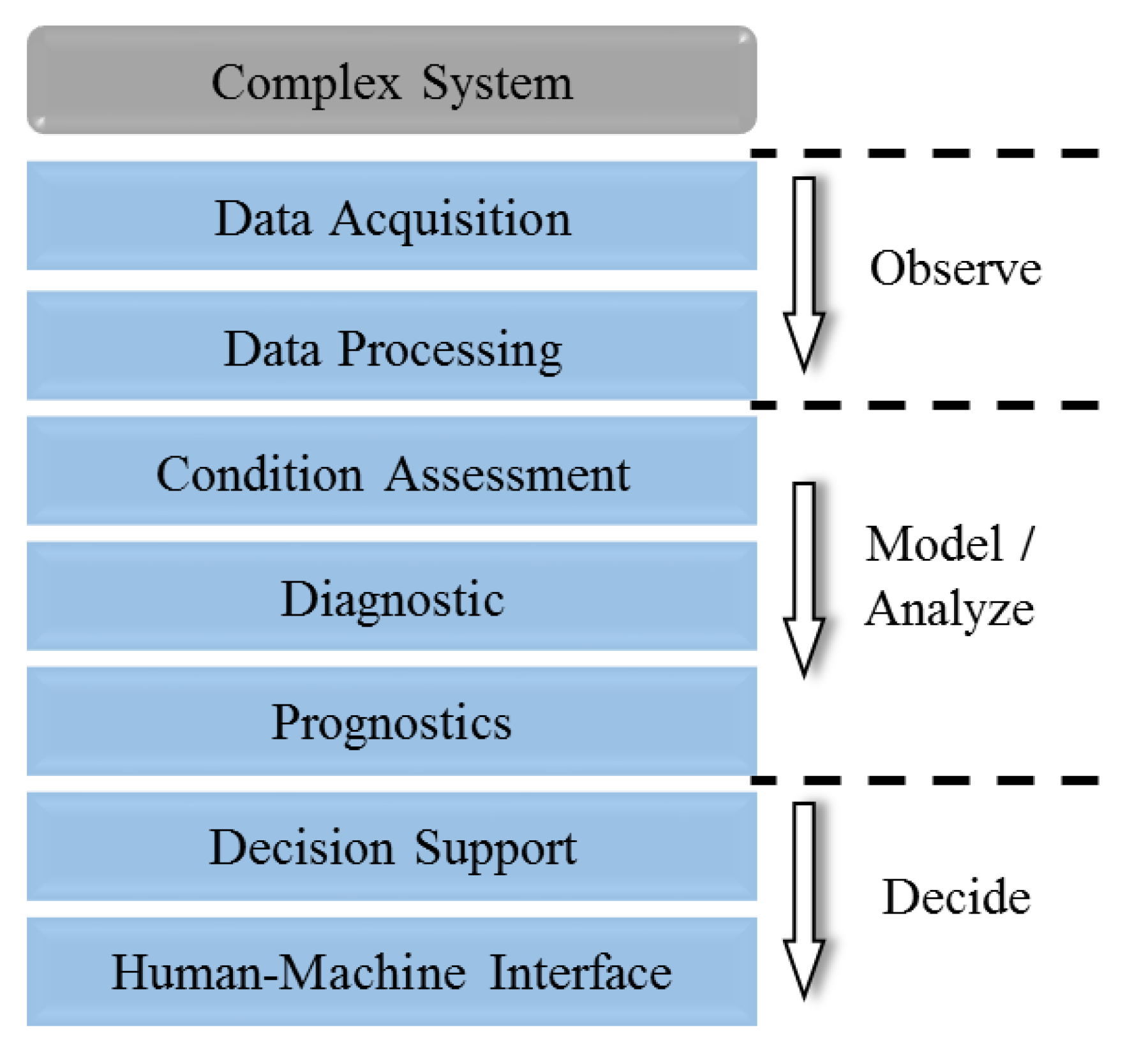


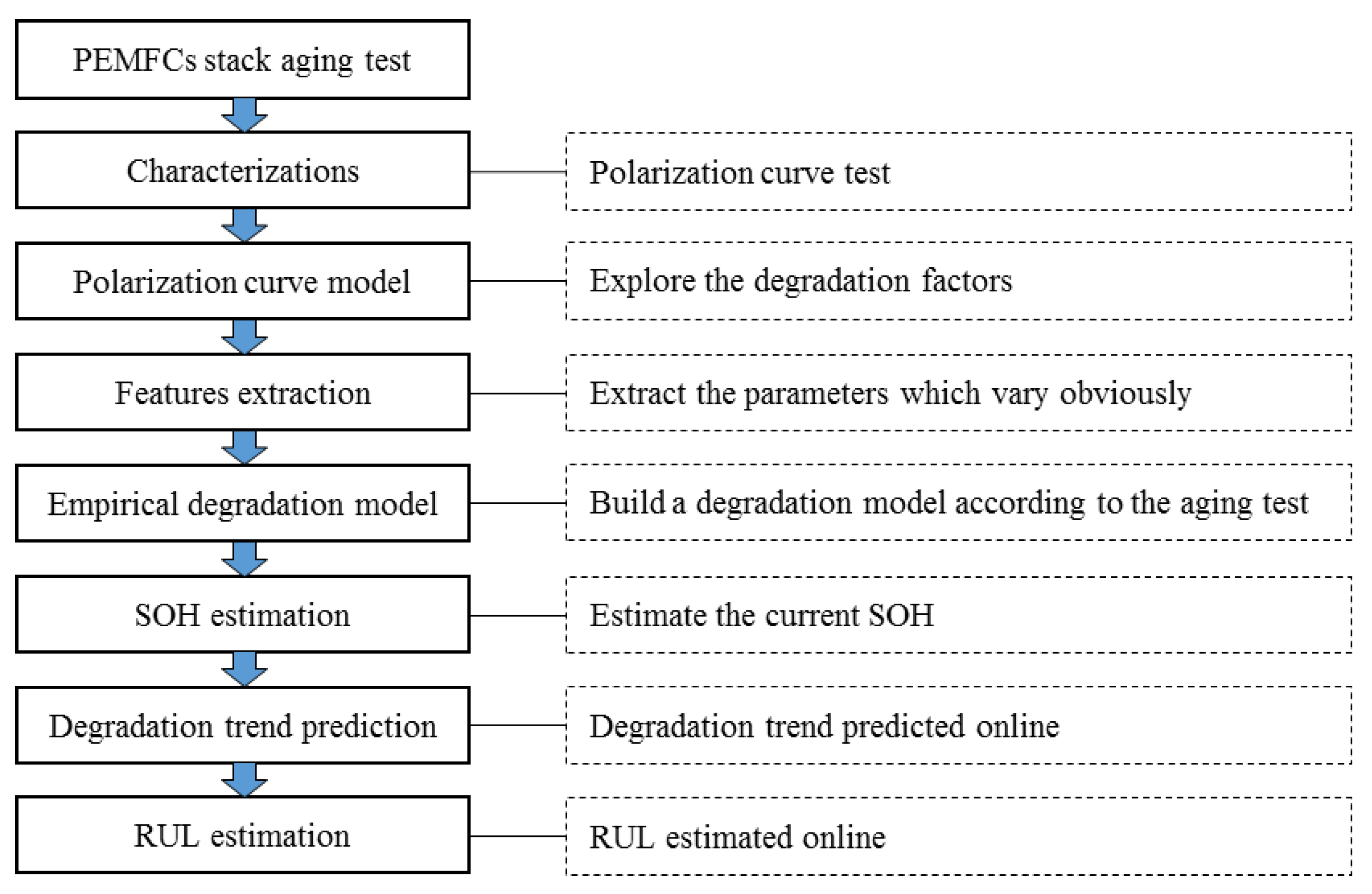
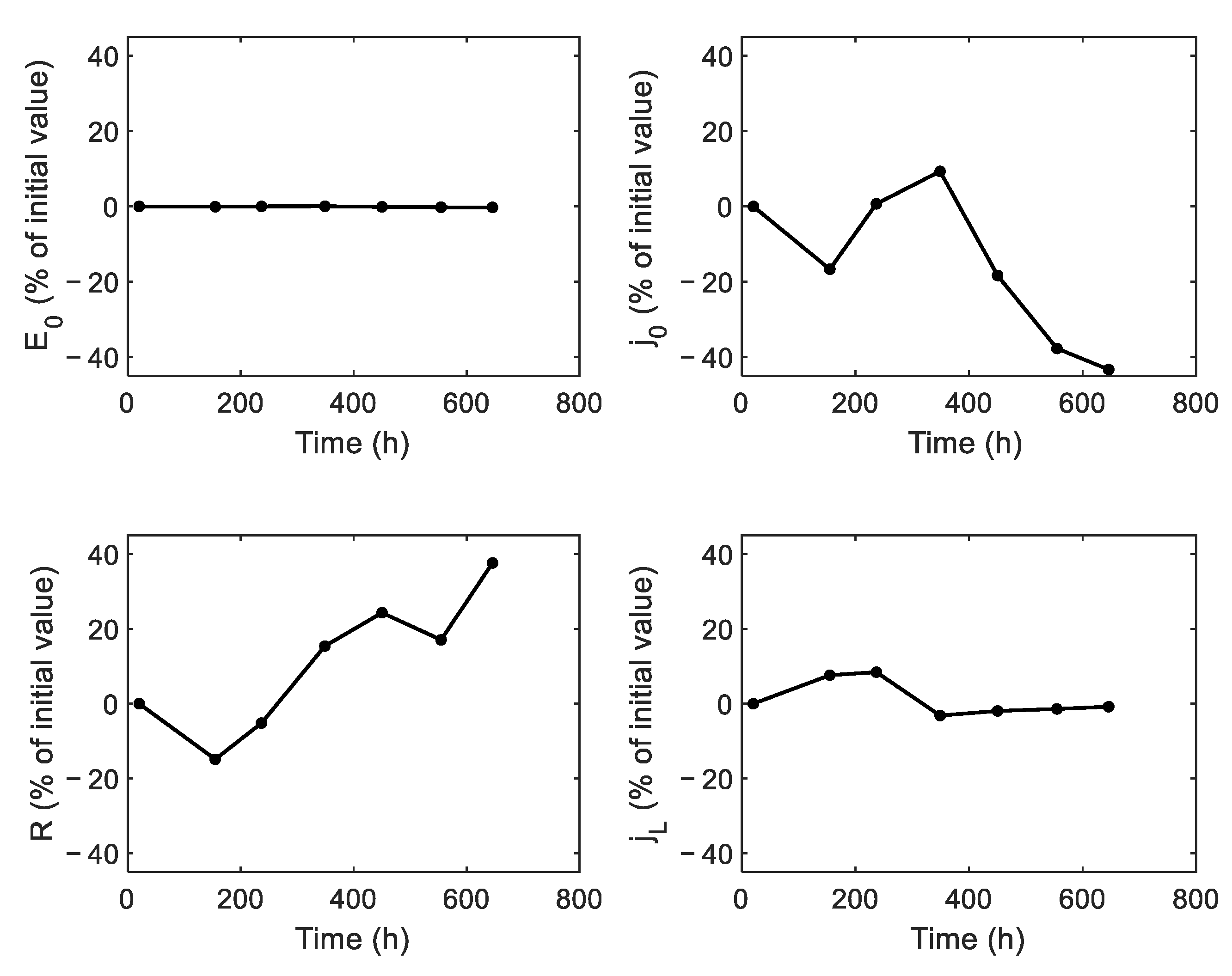

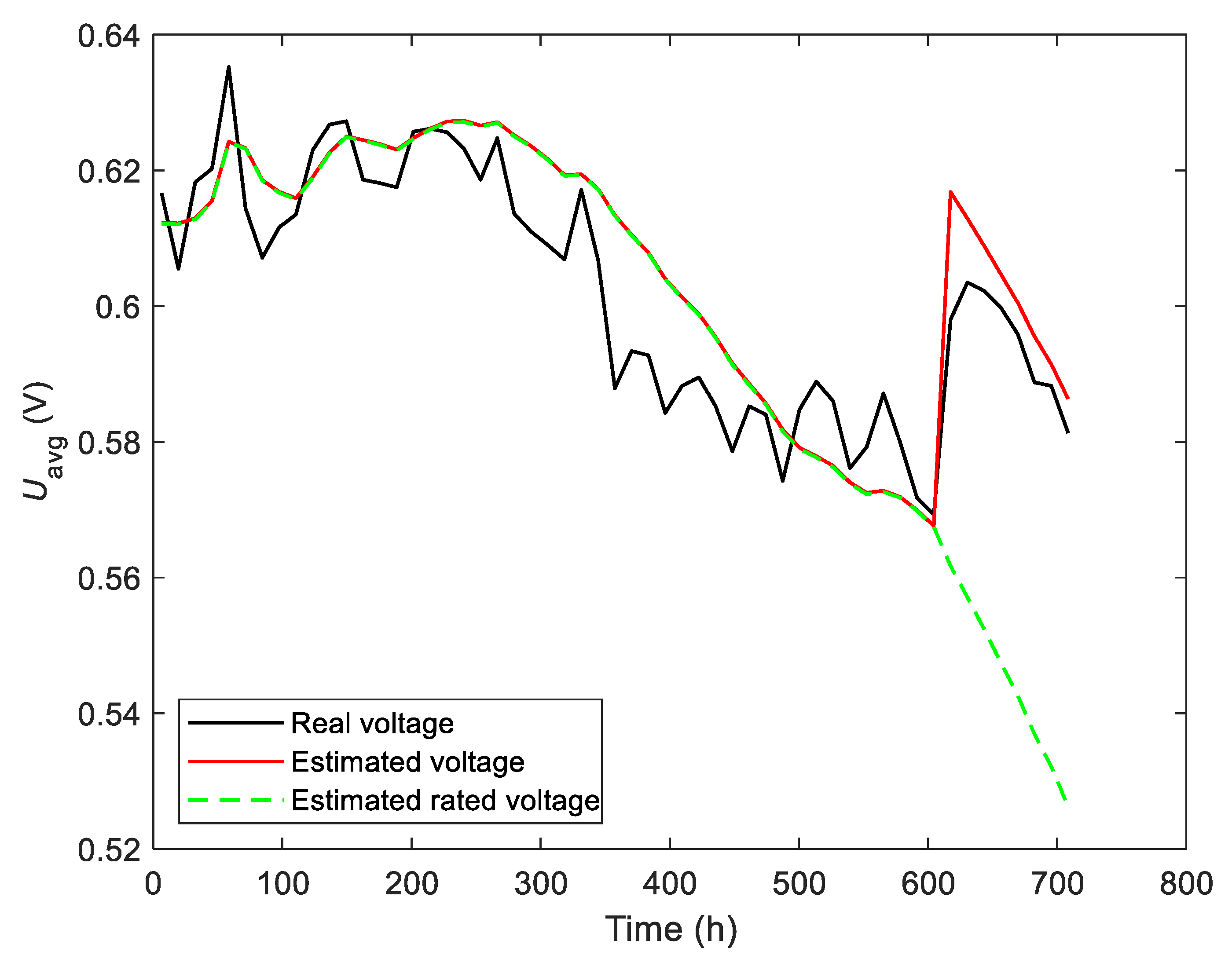


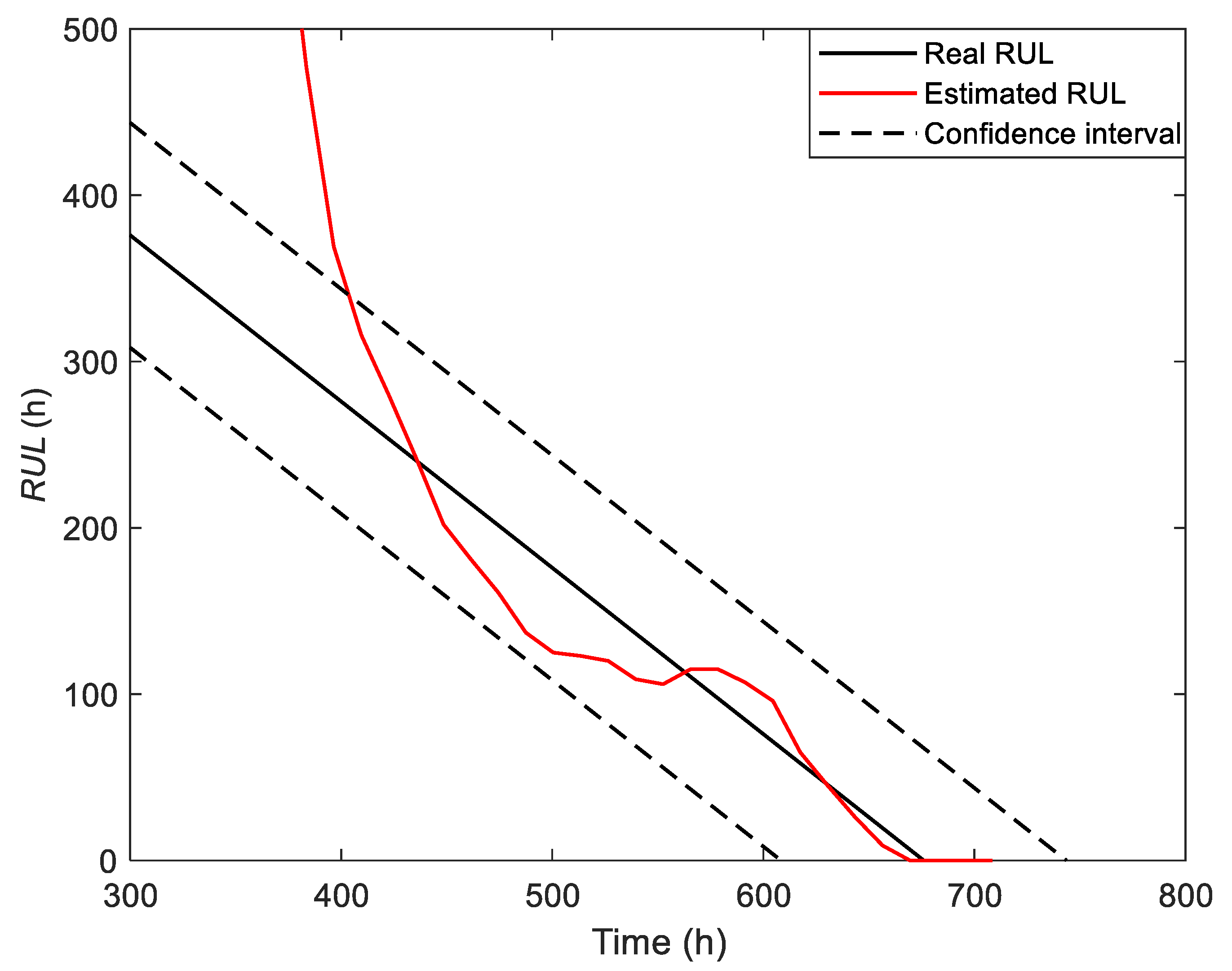
| Components | Information |
|---|---|
| PEMFCs stack | 8 cells |
| Active area (cm2) | 270 |
| Anode platinum loading (mg cm−2) | 0.2 |
| Cathode platinum loading (mg cm−2) | 0.4 |
| Proton exchange membrane | Nafion®211 |
| Flow channel | Parallel flow field |
| Parameters | Range |
|---|---|
| Current density (A cm−2) | 0.8~1.0 |
| Temperature () | 62~67 |
| Anode inlet pressure (bar) | 0.45~0.70 |
| Cathode inlet pressure (bar) | 0.39~0.58 |
| Anode relative humidity (%) | dry gas |
| Cathode relative humidity (%) | 11~40 |
Publisher’s Note: MDPI stays neutral with regard to jurisdictional claims in published maps and institutional affiliations. |
© 2021 by the authors. Licensee MDPI, Basel, Switzerland. This article is an open access article distributed under the terms and conditions of the Creative Commons Attribution (CC BY) license (https://creativecommons.org/licenses/by/4.0/).
Share and Cite
Wang, P.; Liu, H.; Hou, M.; Zheng, L.; Yang, Y.; Geng, J.; Song, W.; Shao, Z. Estimating the Remaining Useful Life of Proton Exchange Membrane Fuel Cells under Variable Loading Conditions Online. Processes 2021, 9, 1459. https://doi.org/10.3390/pr9081459
Wang P, Liu H, Hou M, Zheng L, Yang Y, Geng J, Song W, Shao Z. Estimating the Remaining Useful Life of Proton Exchange Membrane Fuel Cells under Variable Loading Conditions Online. Processes. 2021; 9(8):1459. https://doi.org/10.3390/pr9081459
Chicago/Turabian StyleWang, Penghao, Hao Liu, Ming Hou, Limin Zheng, Yue Yang, Jiangtao Geng, Wei Song, and Zhigang Shao. 2021. "Estimating the Remaining Useful Life of Proton Exchange Membrane Fuel Cells under Variable Loading Conditions Online" Processes 9, no. 8: 1459. https://doi.org/10.3390/pr9081459
APA StyleWang, P., Liu, H., Hou, M., Zheng, L., Yang, Y., Geng, J., Song, W., & Shao, Z. (2021). Estimating the Remaining Useful Life of Proton Exchange Membrane Fuel Cells under Variable Loading Conditions Online. Processes, 9(8), 1459. https://doi.org/10.3390/pr9081459






